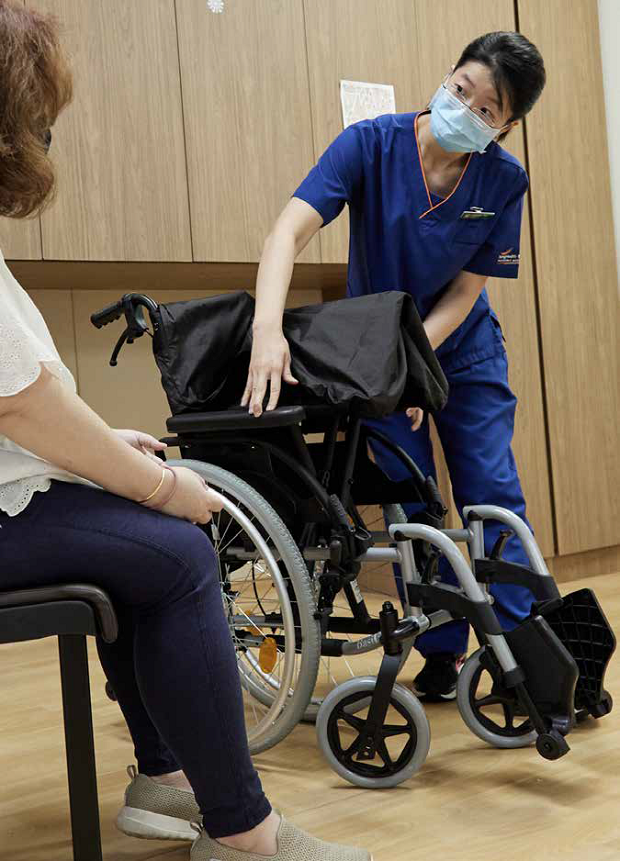

For people who cannot get around on their own, using a wheelchair can offer them a sense of freedom and enhance their quality of life. However, it is important to know what questions to ask in order to discern the right model to get.
When people have difficulties moving around on their own, a wheelchair can offer a sense of freedom and independence. But a wheelchair is not just a chair with wheels.
Wheelchairs come with many different features, and choosing the right wheelchair depends on each patient’s needs and medical condition, said Ms Esther Tan, Occupational Therapist, Occupational Therapy Department, Singapore General Hospital (SGH). “When selecting a wheelchair, we must keep in mind that it should maximise or promote independence such that patients are comfortable, can get around and go about doing the everyday things that they need or want to do,” said Ms Tan.
“Patients who have undergone surgery or who have hurt their lower limbs may not be allowed to weight-bear on their lower limbs, meaning they can’t stand or put their weight on their legs while they recover,” said Ms Tan. Patients recovering from hip or knee surgery, for instance, may need a wheelchair for a few weeks, added Ms Tan, who works mostly with geriatric patients.
Meanwhile, older patients who have reduced mobility should consider using wheelchairs that ensure comfort for prolonged use. “In general, a wheelchair is a means of transport that should not be used for long hours of sitting unless the patient has permanent paralysis. More attention should then be paid to customising a wheelchair for optimal seating posture and pressure relief,” said Ms Tan. For better sitting posture and support, patients should be transferred to chairs when they reach their destination.

Wheelchairs for general everyday use, like the ones available at hospitals and public places, may have bigger rear wheels with a push rim. These allow the user — usually someone with good upper limb strength who also has a good sitting posture — to propel or move the chair himself. Those requiring someone to push — known as a pushchair — have smaller rear wheels and no push rim. A more compact form of the pushchair, known as a transport chair, is more suited for indoor use, such as at airports.
For bigger patients who need wider seats, the sturdy heavy-duty or bariatric wheelchair has a reinforced frame and weighs more than 20kg.
Besides general-use aids, wheelchairs for specific needs are also available. A tilt-in- space wheelchair is recommended for patients with poor head, neck or trunk control, severe stroke or spinal cord injury. With a seat that can be tilted backwards at an angle, this mobility aid can prevent the user from sliding in the seat and also reduce the risk of pressure injury from prolonged sitting.
Another is the reclining wheelchair, which comes with an adjustable backrest that allows the user to go from a sitting to a lying-down position and is suitable for patients who experience sudden drops in blood pressure or are unable to sit upright for prolonged periods.
People with disabilities who are longterm wheelchair users and who want to continue leading an active lifestyle can consider a sports wheelchair. These are customised to the user’s body size and activity needs, and allow participation in sports such as basketball and table tennis while maintaining stability and agility. Sports wheelchairs are compact, can be manouvred easily, and favour users who have a good sitting posture and upper limb strength. While these users may lead an active and sporty lifestyle, they still need to undergo assessment and training to ensure that they are able to manage the sports wheelchair safely.
Users who want independence, especially when traversing longer distances, but do not have sufficient upper body strength or endurance to propel a manual wheelchair, can consider a motorised wheelchair or scooter. They should have good eyesight and cognitive ability to use them safely.

Besides considering the user’s condition and needs, thinking about the activities that he does and the environment that he normally operates in will have a bearing on the size of the wheelchair. Does he visit the hawker centre to buy his meals every day? On the way, will he have to navigate through tight spaces, kerbs or undulating pavements?
Another area of consideration is the needs of the carer. Does the carer, usually a helper, need to bring the wheelchair into and out of the car boot regularly? “We need to look at the weight of the device — will the carer be able to pick it up and put it into the car boot safely? A basic wheelchair can weigh 13kg or more,” Ms Tan said.
Attendant-controlled motorised wheelchairs can be controlled by the caregiver using a remote control or joystick, and may be helpful in situations where the patient cannot self-drive or the caregiver is physically unable to push the wheelchair.
For the user’s comfort, especially when sitting in a wheelchair for long periods, which can lead to pressure injury or pain, a foam, gel or air seat cushion can help to better distribute body pressure.
Patients or caregivers who need help selecting a suitable wheelchair or require training on wheelchair use can ask their doctors for a referral to see an occupational therapist.

Get the latest updates about Singapore Health in your mailbox! Click here to subscribe.













 Get it on Google Play
Get it on Google Play